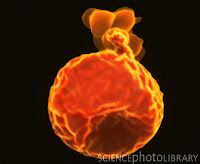Life Cycle Of Plasmodium
 |
| Life Cycle of Malaria Parasites |
The life cycle of plasmodium in human:
Infection
The infection of Plasmodium vivax takes place in human when an infected female anopheles mosquito sucks blood from a healthy person. During feeding, the mosquito injects sporozoites (mortile,spindle-shaped asexual cells), to prevent blood clotting and saliva, thousands of sporozoites are inoculated into human blood; within half and hour the sporozoites reach the liver. There they enter hepatic cells, transform into the tropozoite form and feed on hepatic cells, and reproduce asexually. This asexual division is called schizogony. This process gives rise to thousands of merozoites (plasmodium daughter cells) in the circulatory system and the liver.
Liver Stage
 |
| Coloured TEM of a human red blood cell infected with merozoites |
The P. vivax sporozoite enters a hepatocyte and begins its exoerythrocytic schizogony stage. This is characterized by multiple rounds of nuclear division without cellular segmentation. After a certain number of nuclear divisions, the parasite cell will segment and merozoites are formed.
There are situations where some of the sporozoites do not immediately start to grow and divide after entering the hepatocyte, but remain in a dormant, hypnozoite stage for weeks or months. The duration of latency is variable from one hypnozoite to another and the factors that will eventually trigger growth are not known; this explains how a single infection can be responsible for a series of waves of parasitaemia or "relapses". Different strains of P. vivax have their own characteristic relapse pattern and timing. The earlier stage is exo-erythrocytic generation.
Erythrocytic cycle
 |
| Merozoites of the malaria parasite bursting out of the red blood cell |
Once inside the erythrocyte, the merozoite begins to enlarge as a uninucleate cell termed a ring trophozoite. The trophozoite's nucleus then divides asexually to produce a schizont which contains several nuclei. The schizont then divides and produce mononucleated merozoites. The erythrocyte ruptures and releases toxins throughout the body of the host, bringing about the well-known cycle of fever and chills that is characteristics of malaria.
Sexual phase
The sexual stage includes following processes by which P. vivax reproduces sexually:
- Transfer to mosquito
- Gametogenesis
- Microgametes
- Macrogametes
- Fertilization
- Ookinite
- Oocyst
- Sporogony
It enters a sexual phase when some merizoites in erythrocytes develops into gametocytes,cells capable of producing both male and female gametes. Erythrocyte that contains gametocytes does not rupture. Gametocytes are incapable of producing gametes within their human hosts and do so only when they are extracted from an infected human host by a mosquito.
The life cycle in mosquito:
Formation of gametes
Development of gametes from gametocytes is known as gametogony. When a female Anopheles mosquito bites an infected person, gametocytes and other stages of the parasite are transferred to the stomach where further development occur.
The microgametocytes becomes very active and its nucleus undergoes fission to give 6-8 daughter nuclei which becomes arranged at the periphery. The cytoplasm develops long thin flagella like projections, then a nucleus enter into each one of these extensions. These cytoplasmic extensions later break off as mature male gametes (microgametes). This process of formation of flagella like microgametes or male gametes is known as exflagellation. Macrogametocytes show very little change. It develops a cone of reception at one side and becomes mature as female gamete or macrogametocytes.
Fertilization
 |
| TEM of malaria ookinete in the gut of Anopheles mosquito |
Male gametes move actively in the stomach of mosquito in search of female gamete. Male gamete then enters into female gamete through the cone of reception and the complete fusion of 2 gametes result in the formation of zygote (synkaryon). Process of fusion of male and female gamete is called as syngamy. Fusion of 2 dissimilar gametes is known as anisogamy. The zygote remains inactive for sometime but it soon elongates, becomes vermiform (worm-like) and motile. It is now known as ookinete. The pointed ends of ookinete penetrate the wall of stomach and comes to lie below its outer epithelial layer. Here it becomes spherical and develops a cyst wall around itself. The cyst wall is derived partly from the stomach tissues and partly produced by the zygote itself. At this stage, it is known as the oocyst. The oocyst absorbs nourishment and grow in size. These oocyst protrude (bulge) from the surface of stomach giving it a kind of blistered appearance. In a highly infected mosquito, as many as 1000 oocyst may be seen.
 |
| Malaria oocysts on stomach of mosquito |
Sporogony
The nucleus of oocyst divides repeatedly to form large number of daughter nuclei. At the same time, the cytoplasm develops large vacuoles and forms numerous cytoplasmic masses. These cytoplasmic masses then elongate and a daughter nuclei migrates into each one of them. The resulting sickle-shaped bodies is known as sporozoites. This phase of asexual multiplication is known as sporogony and is completed in about 10-21 days. The oocyst then burst and sporozoites are relaesed into the body cavity of mosquito from where they eventually migrate to the salivary glands of mosquito through blood. The mosquito now becomes infective. Salivary glands of a single infected mosquito may contain as many as 200,000 sporozoites. When the mosquito bites a healthy person, thousands of sporozoites are infected into the blood along with the saliva and the cycle starts again.
Ref:http://highered.mcgraw-hill.com/olc/dl/120090/bio44.swf ,


I would like to ask is it every type of mosquito also can transmit the malaria? :)
ReplyDeleteNot every type of mosquito can transmit malaria. Only genus Anopheles can transmit it. The Anopheles are infected by parasite. There are five plasmodium species that can causes malaria, that is Plasmodium falciparum, Plasmodium vivax, Plasmodium ovale, Plasmodium malaria and Plasmodium knowlesi. Severe disease is largely caused by Plasmodium falciparum while the disease caused by Plasmodium vivax, Plasmodium ovale, and Plasmodium malariae is generally a milder disease that is rarely fatal. Plasmodium knowlesi is a zoonosis that causes malaria in macaques but can also infect humans.
Delete